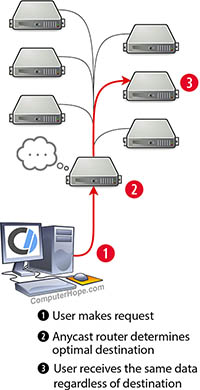Anycast
Updated: 08/02/2020 by Computer Hope

Anycast is a method for routing Internet traffic. In an anycast network, a router can dynamically determine the best destination for data packets. When a user requests data, traffic is routed to different servers depending on a set of determining factors. Regardless of which server is chosen as the destination, the user receives the same data.
Determining factors for destination choice
- Congestion — Like the speed of vehicles on a highway, network performance can be affected by the amount of traffic on any particular Internet route. Using anycast, servers with the least-congested route to the originating request can be chosen.
- Health — When a single server becomes very busy, it might be slow to respond to network requests. Servers that are less busy are considered "healthier," and may be chosen to receive new traffic.
- Geographical location — If a particular server is geographically close to the originating request, network traffic will travel a shorter physical distance, so that the request completes quickly. For instance, a user in Arizona loads a website faster if it's served from California rather than New York. This type of routing is also known as geocast.
- Cost — Sometimes, the cost associated with using some servers may be higher than others, in which case the lowest-cost server may be chosen to handle requests.
- Other — Custom factors can be defined by the service operator.
Anycast is one of the five top techniques for routing Internet traffic. The others are unicast, broadcast, multicast, and geocast.
